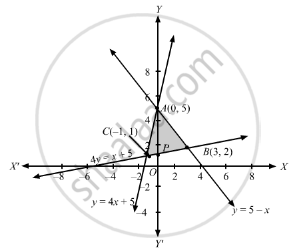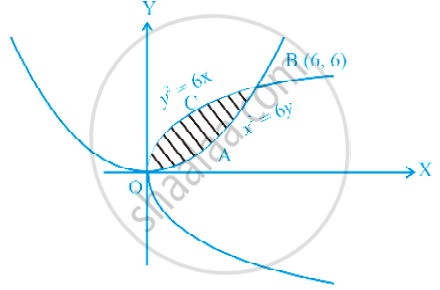Advertisements
Advertisements
Question
Find the area bounded by the lines y = 4x + 5, y = 5 − x and 4y = x + 5.
Solution

We have,
\[y = 4x + 5 . . . . . \left( 1 \right)\]
\[y = 5 - x . . . . . \left( 2 \right)\]
\[4y = x + 5 . . . . . \left( 3 \right)\]
All the three equations represent equations of straight lines
The points of intersection is obtained by solving simultaneous equations
\[\text{ From }\left( 1 \right)\text{ and }\left( 2 \right)\]
\[4x + 5 = 5 - x\]
\[ \Rightarrow 5x = 0\]
\[ \Rightarrow x = 0\]
\[ \Rightarrow y = 5 \]
\[\text{ Thus }A\left( 0, 5 \right)\text{ is the point of intersection of }\left( 1 \right)\text{ and }\left( 2 \right)\]
\[\text{ From }\left( 2 \right)\text{ and }\left( 3 \right)\]
\[4\left( 5 - x \right) = x + 5\]
\[ \Rightarrow 5x = 15\]
\[ \Rightarrow x = 3\]
\[ \Rightarrow y = 2\]
\[\text{ Thus }B\left( 3, 2 \right) \text{ is the point of intersection of } \left( 2 \right)\text{ and }\left( 3 \right)\]
\[\text{ From }\left( 1 \right)\text{ and }\left( 3 \right)\]
\[4\left( 4x + 5 \right) = x + 5\]
\[ \Rightarrow 15x = - 15\]
\[ \Rightarrow x = - 1\]
\[ \Rightarrow y = 1\]
\[\text{ Thus }C\left( - 1, 1 \right)\text{ is the point of intersection of }\left( 1 \right)\text{ and }\left( 3 \right)\]
\[\text{ Area }\left( ABC \right) = \text{ area }\left( ABP \right) + \text{ area }\left( PAB \right)\]
\[ = \int_{- 1}^0 \left[ \left( 4x + 5 \right) - \left( \frac{x + 5}{4} \right) \right] dx + \int_0^3 \left[ \left( 5 - x \right) - \left( \frac{x + 5}{4} \right) \right] dx\]
\[ = \int_{- 1}^0 \left( \frac{15}{4}x + \frac{15}{4} \right) dx + \int_0^3 \left( \frac{15}{4} - \frac{5}{4}x \right) dx\]
\[ = \frac{15}{4} \left[ \frac{x^2}{2} + x \right]_{- 1}^0 + \frac{5}{4} \left[ 3x - \frac{x^2}{2} \right]_0^3 \]
\[ = \frac{15}{4}\left( - \frac{1}{2} + 1 \right) + \frac{5}{4}\left( 9 - \frac{9}{2} \right)\]
\[ = \frac{15}{8} + \left( \frac{5}{4} \times \frac{9}{2} \right)\]
\[ = \frac{15}{8} + \frac{45}{8} \]
\[ = \frac{60}{8}\]
\[ = \frac{15}{2}\text{ sq . units }\]
APPEARS IN
RELATED QUESTIONS
Area bounded by the curve y = x3, the x-axis and the ordinates x = –2 and x = 1 is ______.
Find the area of the region lying in the first quandrant bounded by the curve y2= 4x, X axis and the lines x = 1, x = 4
Find the equation of a curve passing through the point (0, 2), given that the sum of the coordinates of any point on the curve exceeds the slope of the tangent to the curve at that point by 5.
Using integration, find the area of the region bounded between the line x = 2 and the parabola y2 = 8x.
Find the area of the region bounded by the parabola y2 = 4ax and the line x = a.
Find the area lying above the x-axis and under the parabola y = 4x − x2.
Find the area under the curve y = \[\sqrt{6x + 4}\] above x-axis from x = 0 to x = 2. Draw a sketch of curve also.
Draw a rough sketch of the graph of the function y = 2 \[\sqrt{1 - x^2}\] , x ∈ [0, 1] and evaluate the area enclosed between the curve and the x-axis.
Using integration, find the area of the region bounded by the following curves, after making a rough sketch: y = 1 + | x + 1 |, x = −2, x = 3, y = 0.
Draw a rough sketch of the curve y = \[\frac{\pi}{2} + 2 \sin^2 x\] and find the area between x-axis, the curve and the ordinates x = 0, x = π.
Show that the areas under the curves y = sin x and y = sin 2x between x = 0 and x =\[\frac{\pi}{3}\] are in the ratio 2 : 3.
Find the area of the minor segment of the circle \[x^2 + y^2 = a^2\] cut off by the line \[x = \frac{a}{2}\]
Find the area of the region bounded by x2 + 16y = 0 and its latusrectum.
Using integration, find the area of the region bounded by the triangle whose vertices are (2, 1), (3, 4) and (5, 2).
Prove that the area in the first quadrant enclosed by the x-axis, the line x = \[\sqrt{3}y\] and the circle x2 + y2 = 4 is π/3.
Prove that the area common to the two parabolas y = 2x2 and y = x2 + 4 is \[\frac{32}{3}\] sq. units.
Using integration, find the area of the region bounded by the triangle whose vertices are (−1, 2), (1, 5) and (3, 4).
Find the area of the region in the first quadrant enclosed by x-axis, the line y = \[\sqrt{3}x\] and the circle x2 + y2 = 16.
Find the area of the region bounded by y = | x − 1 | and y = 1.
Find the area of the region {(x, y): x2 + y2 ≤ 4, x + y ≥ 2}.
In what ratio does the x-axis divide the area of the region bounded by the parabolas y = 4x − x2 and y = x2− x?
The area bounded by the curve y = loge x and x-axis and the straight line x = e is ___________ .
The area bounded by the curve y2 = 8x and x2 = 8y is ___________ .
The area bounded by the curve y = x |x| and the ordinates x = −1 and x = 1 is given by
Area of the region bounded by the curve y2 = 4x, y-axis and the line y = 3, is
Find the area bounded by the parabola y2 = 4x and the line y = 2x − 4 By using vertical strips.
Find the area of the region bounded by the parabolas y2 = 6x and x2 = 6y.
Find the area of the region bounded by the curves y2 = 9x, y = 3x
Find the area of the region bounded by the curve y2 = 4x, x2 = 4y.
Find the area of the region bounded by y = `sqrt(x)` and y = x.
Find the area bounded by the curve y = `sqrt(x)`, x = 2y + 3 in the first quadrant and x-axis.
Using integration, find the area of the region `{(x, y): 0 ≤ y ≤ sqrt(3)x, x^2 + y^2 ≤ 4}`
The region bounded by the curves `x = 1/2, x = 2, y = log x` and `y = 2^x`, then the area of this region, is
Area of the region bounded by the curve `y^2 = 4x`, `y`-axis and the line `y` = 3 is:
Find the area of the region bounded by the curve `y^2 - x` and the line `x` = 1, `x` = 4 and the `x`-axis.
What is the area of the region bounded by the curve `y^2 = 4x` and the line `x` = 3.
The area bounded by the curve `y = x^3`, the `x`-axis and ordinates `x` = – 2 and `x` = 1
Find the area of the region bounded by curve 4x2 = y and the line y = 8x + 12, using integration.
The area (in square units) of the region bounded by the curves y + 2x2 = 0 and y + 3x2 = 1, is equal to ______.
Find the area of the following region using integration ((x, y) : y2 ≤ 2x and y ≥ x – 4).
